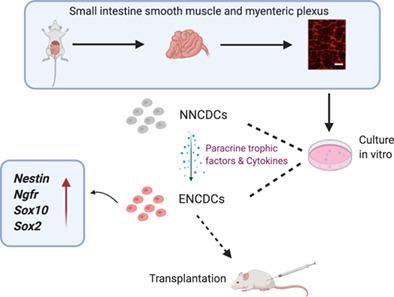当前位置:
X-MOL 学术
›
STEM CELLS
›
论文详情
Our official English website, www.x-mol.net, welcomes your
feedback! (Note: you will need to create a separate account there.)
Enteric mesenchymal cells support the growth of postnatal enteric neural stem cells
STEM CELLS ( IF 4.0 ) Pub Date : 2021-05-02 , DOI: 10.1002/stem.3388 Rhian Stavely 1 , Sukhada Bhave 1 , Wing Lam N Ho 1 , Minhal Ahmed 1, 2 , Weikang Pan 1, 3 , Ahmed A Rahman 1 , Jessica Ulloa 1 , Nicole Bousquet 1 , Meredith Omer 1 , Richard Guyer 1 , Nandor Nagy 1, 4 , Allan M Goldstein 1 , Ryo Hotta 1
STEM CELLS ( IF 4.0 ) Pub Date : 2021-05-02 , DOI: 10.1002/stem.3388 Rhian Stavely 1 , Sukhada Bhave 1 , Wing Lam N Ho 1 , Minhal Ahmed 1, 2 , Weikang Pan 1, 3 , Ahmed A Rahman 1 , Jessica Ulloa 1 , Nicole Bousquet 1 , Meredith Omer 1 , Richard Guyer 1 , Nandor Nagy 1, 4 , Allan M Goldstein 1 , Ryo Hotta 1
Affiliation

|
Interplay between embryonic enteric neural stem cells (ENSCs) and enteric mesenchymal cells (EMCs) in the embryonic gut is essential for normal development of the enteric nervous system. Disruption of these interactions underlies the pathogenesis of intestinal aganglionosis in Hirschsprung disease (HSCR). ENSC therapy has been proposed as a possible treatment for HSCR, but whether the survival and development of postnatal-derived ENSCs similarly rely on signals from the mesenchymal environment is unknown and has important implications for developing protocols to expand ENSCs for cell transplantation therapy. Enteric neural crest-derived cells (ENCDCs) and EMCs were cultured from the small intestine of Wnt1-Rosa26-tdTomato mice. EMCs promoted the expansion of ENCDCs 9.5-fold by inducing ENSC properties, including expression of Nes, Sox10, Sox2, and Ngfr. EMCs enhanced the neurosphere-forming ability of ENCDCs, and this persisted after withdrawal of the EMCs. These effects were mediated by paracrine factors and several ligands known to support neural stem cells were identified in EMCs. Using the optimized expansion procedures, neurospheres were generated from small intestine of the Ednrb−/− mouse model of HSCR. These ENSCs had similar proliferative and migratory capacity to Ednrb+/+ ENSCs, albeit neurospheres contained fewer neurons. ENSCs derived from Ednrb−/− mice generated functional neurons with similar calcium responses to Ednrb+/+ ENSCs and survived after transplantation into the aganglionic colon of Ednrb−/− recipients. EMCs act as supporting cells to ENSCs postnatally via an array of synergistically acting paracrine signaling factors. These properties can be leveraged to expand autologous ENSCs from patients with HSCR mutations for therapeutic application.
中文翻译:

肠间充质细胞支持出生后肠神经干细胞的生长
胚胎肠道中的胚胎肠神经干细胞(ENSC)和肠间充质细胞(EMC)之间的相互作用对于肠神经系统的正常发育至关重要。这些相互作用的破坏是先天性巨结肠症 (HSCR) 中肠道神经节缺失症发病机制的基础。 ENSC 疗法已被提议作为 HSCR 的一种可能治疗方法,但出生后来源的 ENSC 的生存和发育是否同样依赖于来自间充质环境的信号尚不清楚,并且对于制定扩展 ENSC 用于细胞移植治疗的方案具有重要意义。肠神经嵴衍生细胞 (ENCDC) 和 EMC 从Wnt1-Rosa26-tdTomato小鼠的小肠中培养。 EMC 通过诱导 ENSC 特性(包括Nes 、 Sox10 、 Sox2和Ngfr的表达),促进 ENCDC 扩展 9.5 倍。 EMCs 增强了 ENCDCs 的神经球形成能力,并且这种情况在 EMCs 撤回后仍然存在。这些效应是由旁分泌因子介导的,并且在 EMC 中鉴定出了几种已知支持神经干细胞的配体。使用优化的扩展程序,从 HSCR 的Ednrb −/−小鼠模型的小肠中生成神经球。这些 ENSC 与Ednrb +/+ ENSC 具有相似的增殖和迁移能力,尽管神经球含有较少的神经元。 源自Ednrb −/−小鼠的 ENSC 产生了与Ednrb +/+ ENSC 具有相似钙反应的功能性神经元,并在移植到Ednrb −/−受体的无神经节结肠后存活。 EMC 在出生后通过一系列协同作用的旁分泌信号因子充当 ENSC 的支持细胞。这些特性可用于扩展来自 HSCR 突变患者的自体 ENSC,用于治疗应用。
更新日期:2021-05-02
中文翻译:

肠间充质细胞支持出生后肠神经干细胞的生长
胚胎肠道中的胚胎肠神经干细胞(ENSC)和肠间充质细胞(EMC)之间的相互作用对于肠神经系统的正常发育至关重要。这些相互作用的破坏是先天性巨结肠症 (HSCR) 中肠道神经节缺失症发病机制的基础。 ENSC 疗法已被提议作为 HSCR 的一种可能治疗方法,但出生后来源的 ENSC 的生存和发育是否同样依赖于来自间充质环境的信号尚不清楚,并且对于制定扩展 ENSC 用于细胞移植治疗的方案具有重要意义。肠神经嵴衍生细胞 (ENCDC) 和 EMC 从Wnt1-Rosa26-tdTomato小鼠的小肠中培养。 EMC 通过诱导 ENSC 特性(包括Nes 、 Sox10 、 Sox2和Ngfr的表达),促进 ENCDC 扩展 9.5 倍。 EMCs 增强了 ENCDCs 的神经球形成能力,并且这种情况在 EMCs 撤回后仍然存在。这些效应是由旁分泌因子介导的,并且在 EMC 中鉴定出了几种已知支持神经干细胞的配体。使用优化的扩展程序,从 HSCR 的Ednrb −/−小鼠模型的小肠中生成神经球。这些 ENSC 与Ednrb +/+ ENSC 具有相似的增殖和迁移能力,尽管神经球含有较少的神经元。 源自Ednrb −/−小鼠的 ENSC 产生了与Ednrb +/+ ENSC 具有相似钙反应的功能性神经元,并在移植到Ednrb −/−受体的无神经节结肠后存活。 EMC 在出生后通过一系列协同作用的旁分泌信号因子充当 ENSC 的支持细胞。这些特性可用于扩展来自 HSCR 突变患者的自体 ENSC,用于治疗应用。











































 京公网安备 11010802027423号
京公网安备 11010802027423号